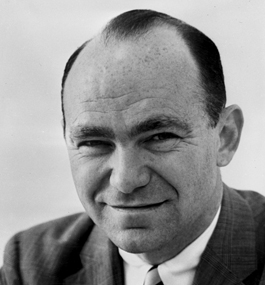A Sixth Sense for Fine-Art Finds

Brandeis Archives and Special Collections
Sam Hunter
It’s safe to say that Sam Hunter — founding director of the Rose Art Museum, who died on July 27, 2014, in Princeton, N.J., at age 91 — had a very good eye.
In the early 1960s, financed by a $50,000 gift from Leon Mnuchin and his wife, Harriet Gevirtz-Mnuchin, Hunter made acquisitions that established the Rose as a major force in the art world.
More than that, Hunter gathered these works — masterpieces by Jasper Johns, Robert Rauschenberg, Roy Lichtenstein, Andy Warhol, Ellsworth Kelly, Marisol and other leading artists — without spending more than $5,000 per painting. The iconic artwork he selected formed the core of the Rose’s collection and continues to set the tone for the museum’s acquisition and exhibition practices.
As he mourned Hunter’s death, President Frederick Lawrence reaffirmed the art expert’s place in Brandeis history. Hunter’s “prescient purchases propelled the museum into the consciousness of the art world just a few years after its founding,” the president said. “His impact on the Rose in particular and the university in general continues to this day.”
A native of Springfield, Mass., Hunter graduated from Williams College in 1943. He began his art career in 1947, when he joined The New York Times as an art critic. He went on to serve as an editor at art publisher Harry N. Abrams Inc., then became editor of Arts Magazine. In 1955, he was appointed associate professor of art history at UCLA, leaving in 1956 to become curator of painting and sculpture at New York City’s Museum of Modern Art. Two years later, he was named chief curator and acting director at the Minneapolis Institute of Arts.
Hunter came to Brandeis in 1960 as director of the Poses Institute of Fine Arts, and shortly thereafter became the Rose’s first director. Almost immediately, Hunter and Mnuchin started combing New York’s galleries for interesting art, often with Robert Scull, a friend of Mnuchin and a prominent Pop Art collector.
After he left Brandeis in 1965, Hunter was appointed director of the Jewish Museum and lectured as a visiting professor at Cornell. In 1969, he became professor of art history at Princeton and curator of modern art at the university’s art museum. He retired from Princeton as professor emeritus in 1991.
Christopher Bedford, the Henry and Lois Foster Director of the Rose, points out that Hunter was a towering figure in both curatorial and academic spheres.
“He had one foot in the world of museums and one foot in the world of scholarship, a model for how the Rose thinks of itself today,” Bedford says. “That dual commitment continues to represent the Rose in the work we do today.”
Bedford has announced he is naming the Rose’s newly established emerging-artists fund in Hunter’s memory.
